radiator cap CHEVROLET AVEO 2002 Service User Guide
[x] Cancel search | Manufacturer: CHEVROLET, Model Year: 2002, Model line: AVEO, Model: CHEVROLET AVEO 2002Pages: 5127, PDF Size: 41.82 MB
Page 1739 of 5127
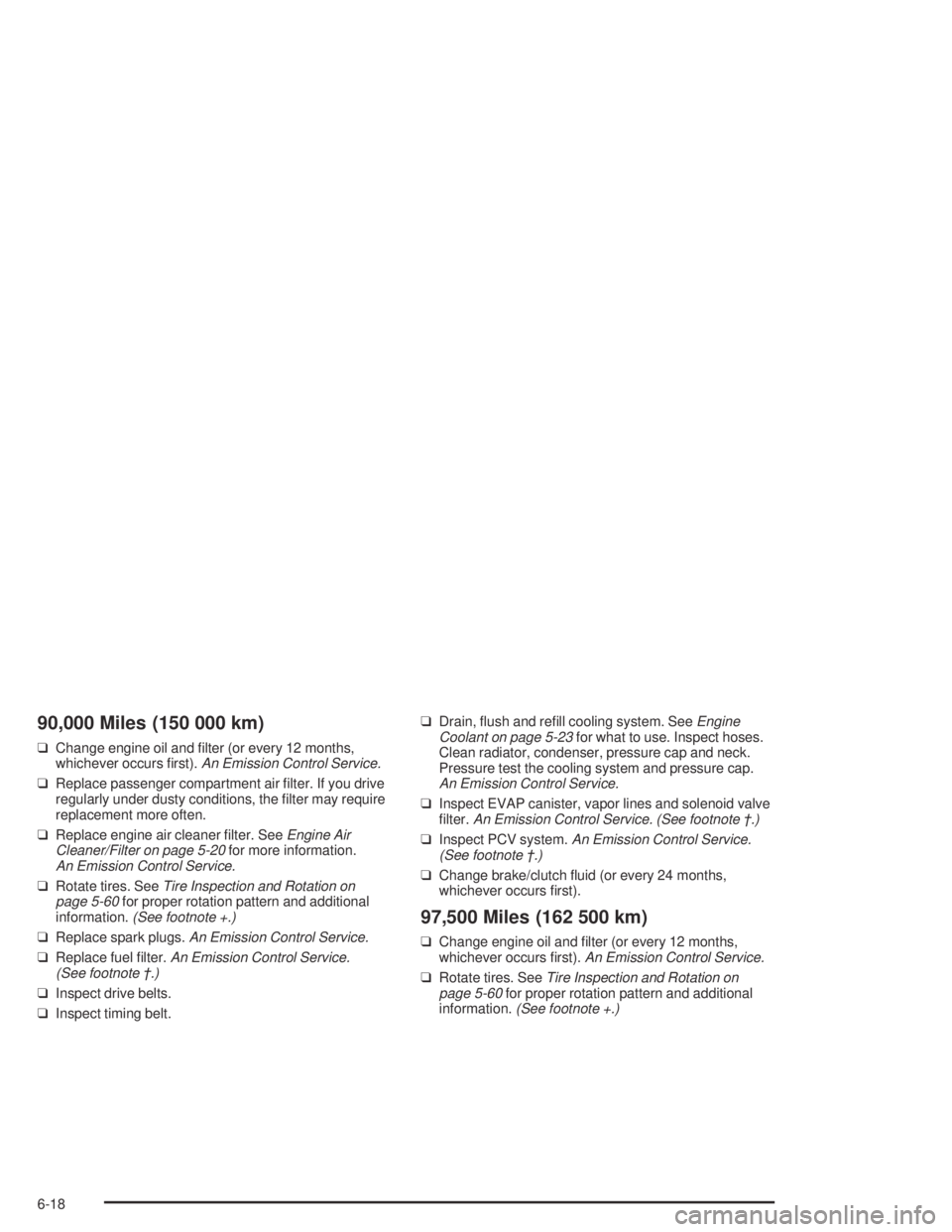
90,000 Miles (150 000 km)
❑Change engine oil and filter (or every 12 months,
whichever occurs first).An Emission Control Service.
❑Replace passenger compartment air filter. If you drive
regularly under dusty conditions, the filter may require
replacement more often.
❑Replace engine air cleaner filter. SeeEngine Air
Cleaner/Filter on page 5-20for more information.
An Emission Control Service.
❑Rotate tires. SeeTire Inspection and Rotation on
page 5-60for proper rotation pattern and additional
information.(See footnote +.)
❑Replace spark plugs.An Emission Control Service.
❑Replace fuel filter.An Emission Control Service.
(See footnote †.)
❑Inspect drive belts.
❑Inspect timing belt.❑Drain, flush and refill cooling system. SeeEngine
Coolant on page 5-23for what to use. Inspect hoses.
Clean radiator, condenser, pressure cap and neck.
Pressure test the cooling system and pressure cap.
An Emission Control Service.
❑Inspect EVAP canister, vapor lines and solenoid valve
filter.An Emission Control Service. (See footnote †.)
❑Inspect PCV system.An Emission Control Service.
(See footnote †.)
❑Change brake/clutch fluid (or every 24 months,
whichever occurs first).
97,500 Miles (162 500 km)
❑Change engine oil and filter (or every 12 months,
whichever occurs first).An Emission Control Service.
❑Rotate tires. SeeTire Inspection and Rotation on
page 5-60for proper rotation pattern and additional
information.(See footnote +.)
6-18
Page 1746 of 5127
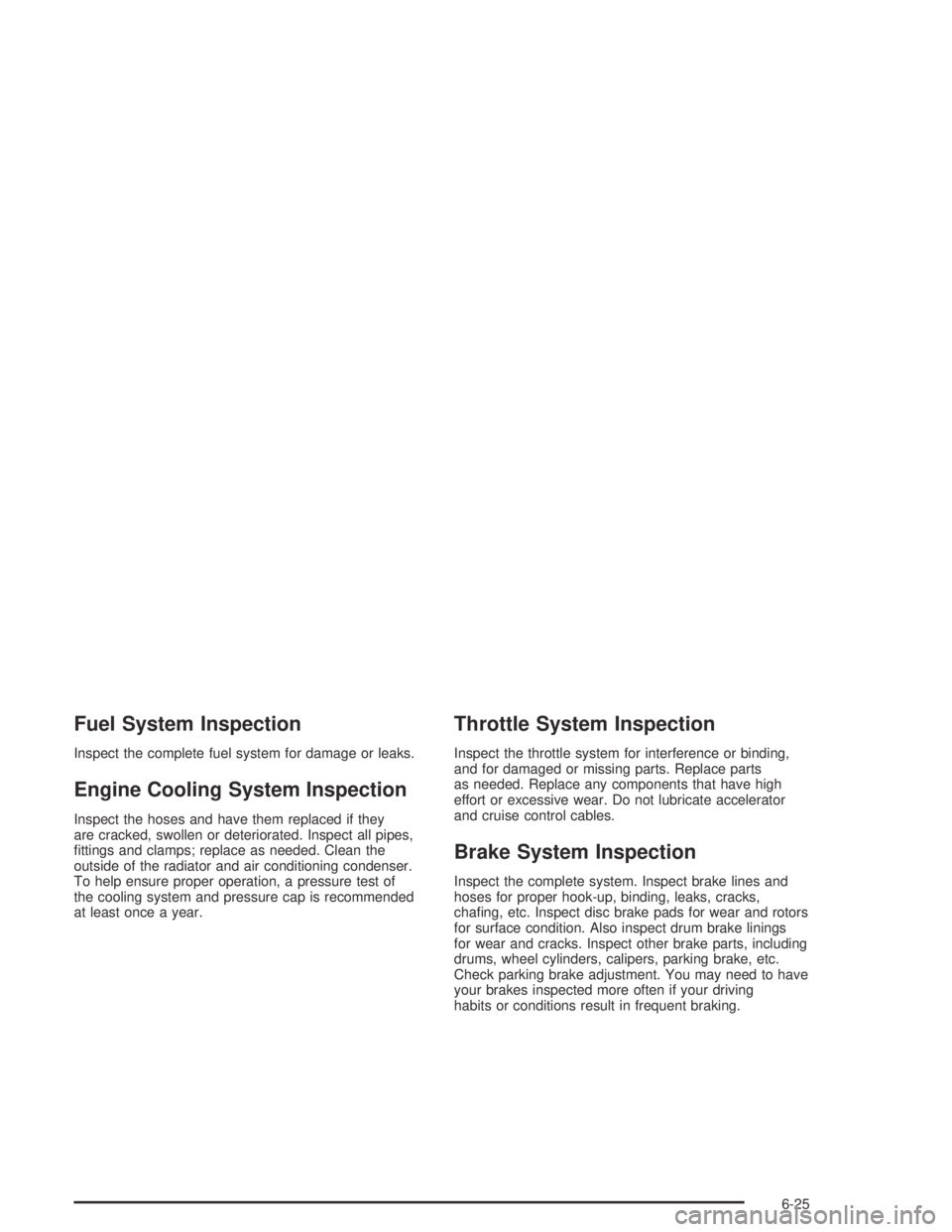
Fuel System Inspection
Inspect the complete fuel system for damage or leaks.
Engine Cooling System Inspection
Inspect the hoses and have them replaced if they
are cracked, swollen or deteriorated. Inspect all pipes,
fittings and clamps; replace as needed. Clean the
outside of the radiator and air conditioning condenser.
To help ensure proper operation, a pressure test of
the cooling system and pressure cap is recommended
at least once a year.
Throttle System Inspection
Inspect the throttle system for interference or binding,
and for damaged or missing parts. Replace parts
as needed. Replace any components that have high
effort or excessive wear. Do not lubricate accelerator
and cruise control cables.
Brake System Inspection
Inspect the complete system. Inspect brake lines and
hoses for proper hook-up, binding, leaks, cracks,
chafing, etc. Inspect disc brake pads for wear and rotors
for surface condition. Also inspect drum brake linings
for wear and cracks. Inspect other brake parts, including
drums, wheel cylinders, calipers, parking brake, etc.
Check parking brake adjustment. You may need to have
your brakes inspected more often if your driving
habits or conditions result in frequent braking.
6-25
Page 2022 of 5127
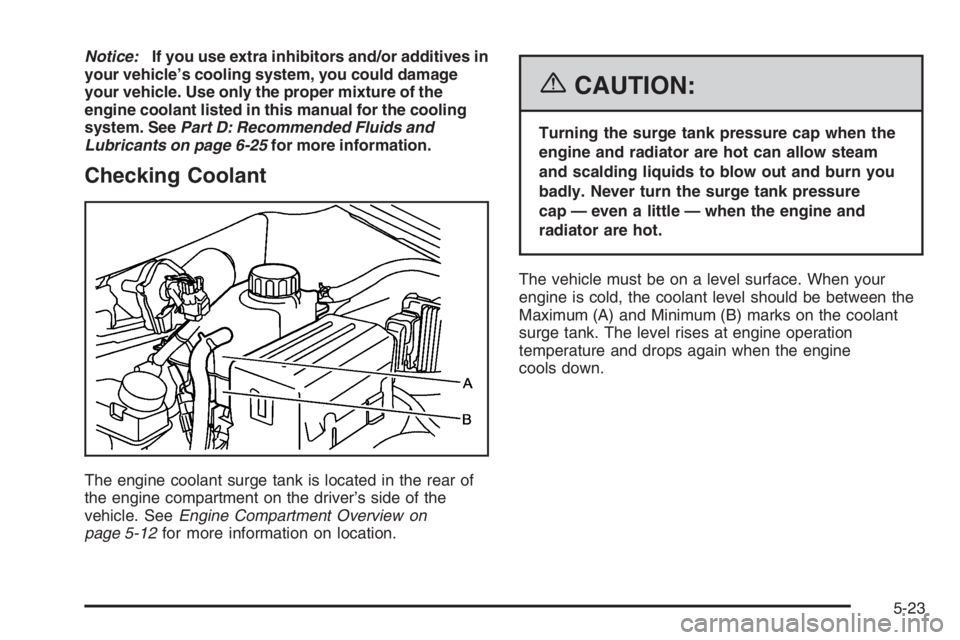
Notice:If you use extra inhibitors and/or additives in
your vehicle’s cooling system, you could damage
your vehicle. Use only the proper mixture of the
engine coolant listed in this manual for the cooling
system. SeePart D: Recommended Fluids and
Lubricants on page 6-25for more information.
Checking Coolant
The engine coolant surge tank is located in the rear of
the engine compartment on the driver’s side of the
vehicle. SeeEngine Compartment Overview on
page 5-12for more information on location.
{CAUTION:
Turning the surge tank pressure cap when the
engine and radiator are hot can allow steam
and scalding liquids to blow out and burn you
badly. Never turn the surge tank pressure
cap — even a little — when the engine and
radiator are hot.
The vehicle must be on a level surface. When your
engine is cold, the coolant level should be between the
Maximum (A) and Minimum (B) marks on the coolant
surge tank. The level rises at engine operation
temperature and drops again when the engine
cools down.
5-23
Page 2025 of 5127
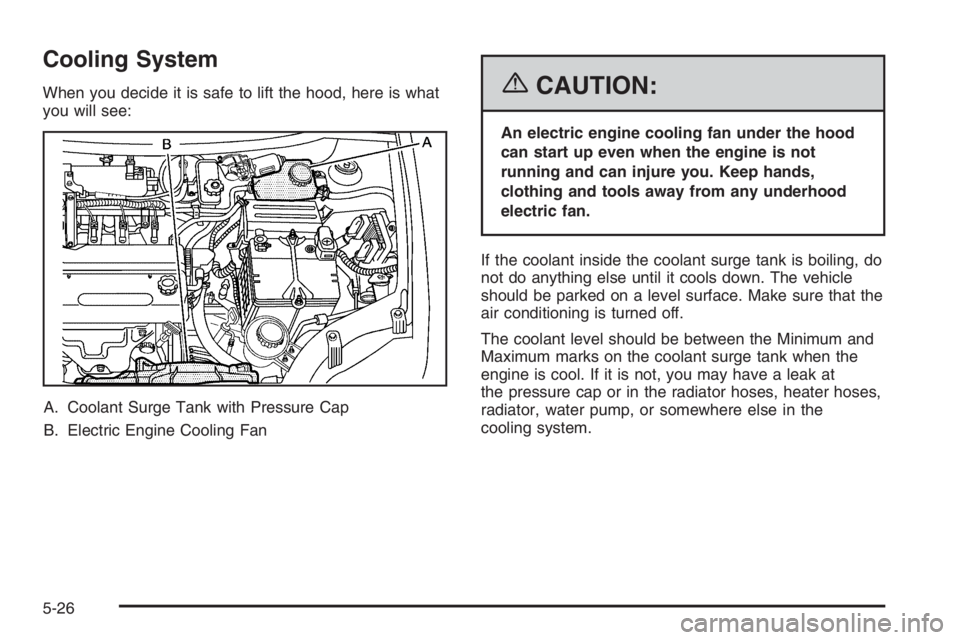
Cooling System
When you decide it is safe to lift the hood, here is what
you will see:
A. Coolant Surge Tank with Pressure Cap
B. Electric Engine Cooling Fan{CAUTION:
An electric engine cooling fan under the hood
can start up even when the engine is not
running and can injure you. Keep hands,
clothing and tools away from any underhood
electric fan.
If the coolant inside the coolant surge tank is boiling, do
not do anything else until it cools down. The vehicle
should be parked on a level surface. Make sure that the
air conditioning is turned off.
The coolant level should be between the Minimum and
Maximum marks on the coolant surge tank when the
engine is cool. If it is not, you may have a leak at
the pressure cap or in the radiator hoses, heater hoses,
radiator, water pump, or somewhere else in the
cooling system.
5-26
Page 2026 of 5127
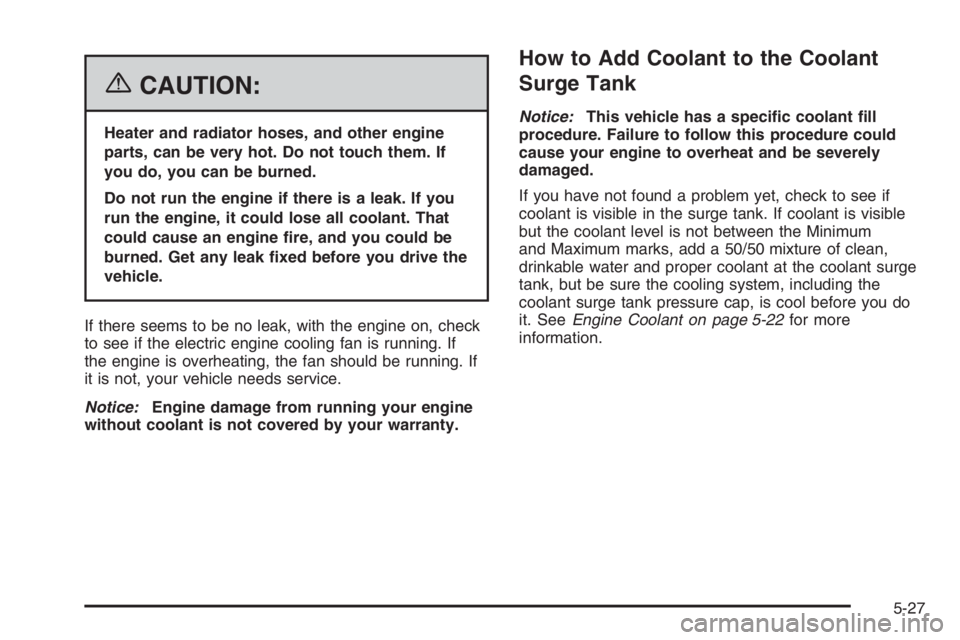
{CAUTION:
Heater and radiator hoses, and other engine
parts, can be very hot. Do not touch them. If
you do, you can be burned.
Do not run the engine if there is a leak. If you
run the engine, it could lose all coolant. That
could cause an engine �re, and you could be
burned. Get any leak �xed before you drive the
vehicle.
If there seems to be no leak, with the engine on, check
to see if the electric engine cooling fan is running. If
the engine is overheating, the fan should be running. If
it is not, your vehicle needs service.
Notice:Engine damage from running your engine
without coolant is not covered by your warranty.
How to Add Coolant to the Coolant
Surge Tank
Notice:This vehicle has a speci�c coolant �ll
procedure. Failure to follow this procedure could
cause your engine to overheat and be severely
damaged.
If you have not found a problem yet, check to see if
coolant is visible in the surge tank. If coolant is visible
but the coolant level is not between the Minimum
and Maximum marks, add a 50/50 mixture of clean,
drinkable water and proper coolant at the coolant surge
tank, but be sure the cooling system, including the
coolant surge tank pressure cap, is cool before you do
it. SeeEngine Coolant on page 5-22for more
information.
5-27
Page 2027 of 5127
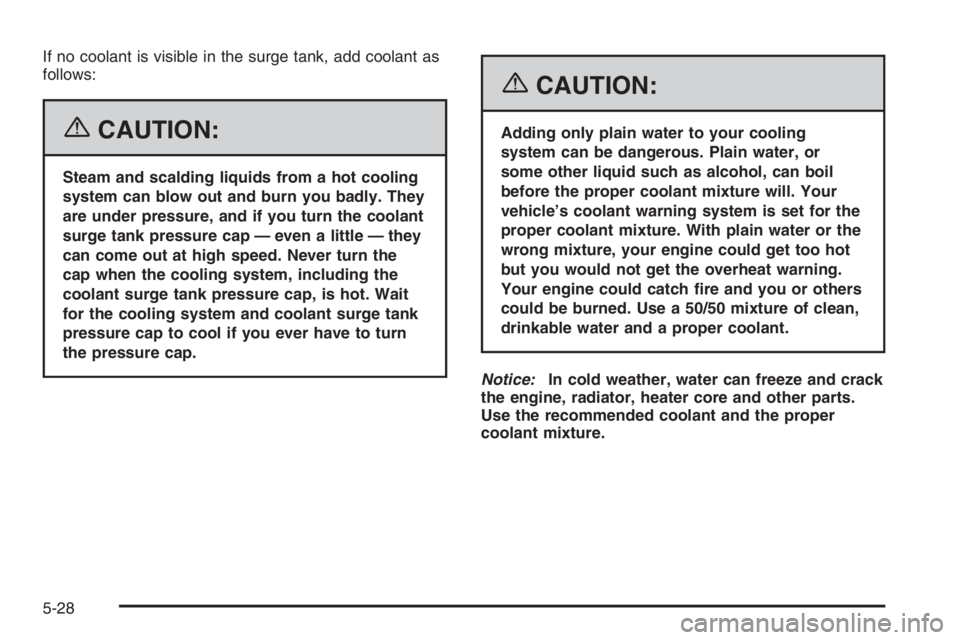
If no coolant is visible in the surge tank, add coolant as
follows:
{CAUTION:
Steam and scalding liquids from a hot cooling
system can blow out and burn you badly. They
are under pressure, and if you turn the coolant
surge tank pressure cap — even a little — they
can come out at high speed. Never turn the
cap when the cooling system, including the
coolant surge tank pressure cap, is hot. Wait
for the cooling system and coolant surge tank
pressure cap to cool if you ever have to turn
the pressure cap.
{CAUTION:
Adding only plain water to your cooling
system can be dangerous. Plain water, or
some other liquid such as alcohol, can boil
before the proper coolant mixture will. Your
vehicle’s coolant warning system is set for the
proper coolant mixture. With plain water or the
wrong mixture, your engine could get too hot
but you would not get the overheat warning.
Your engine could catch �re and you or others
could be burned. Use a 50/50 mixture of clean,
drinkable water and a proper coolant.
Notice:In cold weather, water can freeze and crack
the engine, radiator, heater core and other parts.
Use the recommended coolant and the proper
coolant mixture.
5-28
Page 2028 of 5127
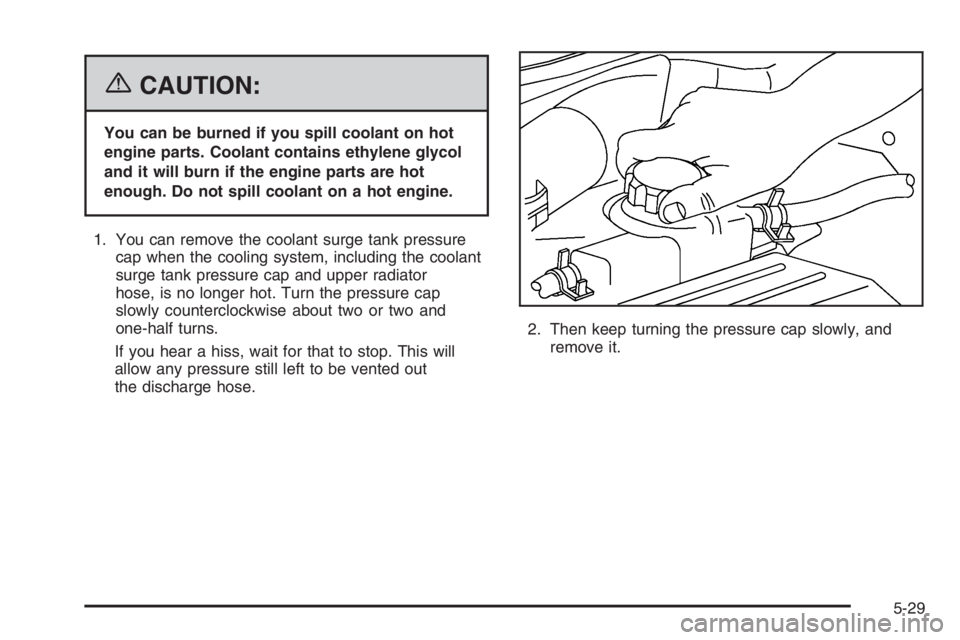
{CAUTION:
You can be burned if you spill coolant on hot
engine parts. Coolant contains ethylene glycol
and it will burn if the engine parts are hot
enough. Do not spill coolant on a hot engine.
1. You can remove the coolant surge tank pressure
cap when the cooling system, including the coolant
surge tank pressure cap and upper radiator
hose, is no longer hot. Turn the pressure cap
slowly counterclockwise about two or two and
one-half turns.
If you hear a hiss, wait for that to stop. This will
allow any pressure still left to be vented out
the discharge hose.2. Then keep turning the pressure cap slowly, and
remove it.
5-29
Page 2029 of 5127
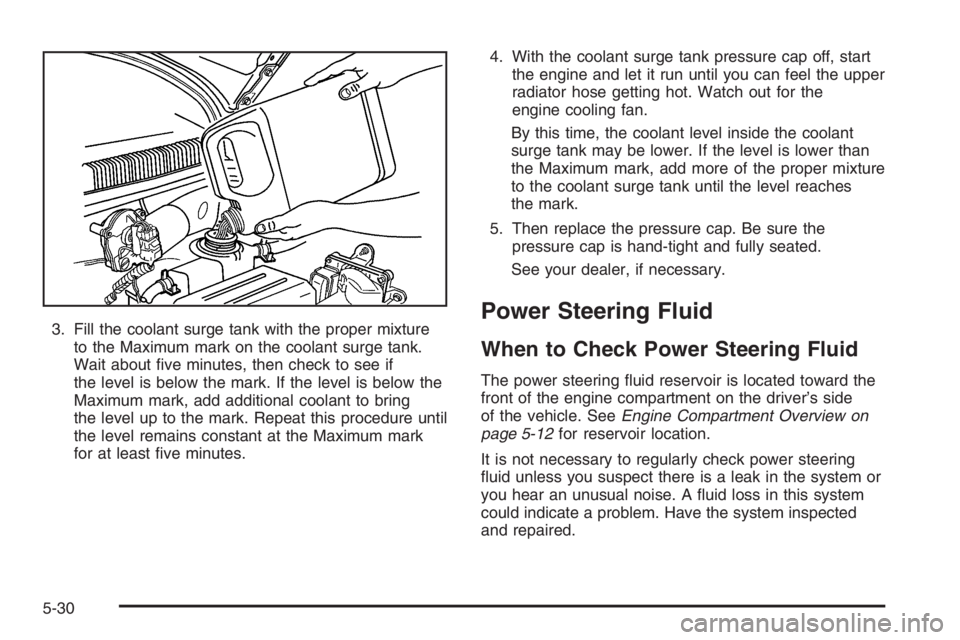
3. Fill the coolant surge tank with the proper mixture
to the Maximum mark on the coolant surge tank.
Wait about five minutes, then check to see if
the level is below the mark. If the level is below the
Maximum mark, add additional coolant to bring
the level up to the mark. Repeat this procedure until
the level remains constant at the Maximum mark
for at least five minutes.4. With the coolant surge tank pressure cap off, start
the engine and let it run until you can feel the upper
radiator hose getting hot. Watch out for the
engine cooling fan.
By this time, the coolant level inside the coolant
surge tank may be lower. If the level is lower than
the Maximum mark, add more of the proper mixture
to the coolant surge tank until the level reaches
the mark.
5. Then replace the pressure cap. Be sure the
pressure cap is hand-tight and fully seated.
See your dealer, if necessary.Power Steering Fluid
When to Check Power Steering Fluid
The power steering fluid reservoir is located toward the
front of the engine compartment on the driver’s side
of the vehicle. SeeEngine Compartment Overview on
page 5-12for reservoir location.
It is not necessary to regularly check power steering
fluid unless you suspect there is a leak in the system or
you hear an unusual noise. A fluid loss in this system
could indicate a problem. Have the system inspected
and repaired.
5-30
Page 2089 of 5127
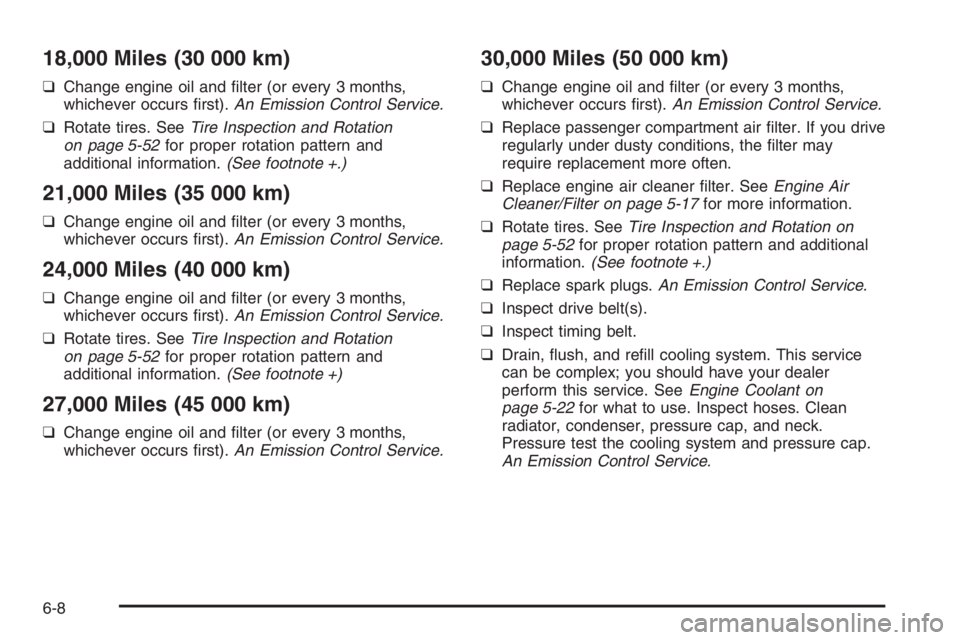
18,000 Miles (30 000 km)
❑ Change engine oil and filter (or every 3 months,
whichever occurs first). An Emission Control Service.
❑ Rotate tires. See Tire Inspection and Rotation
on page 5-52 for proper rotation pattern and
additional information. (See footnote +.)
21,000 Miles (35 000 km)
❑Change engine oil and filter (or every 3 months,
whichever occurs first). An Emission Control Service.
24,000 Miles (40 000 km)
❑Change engine oil and filter (or every 3 months,
whichever occurs first). An Emission Control Service.
❑ Rotate tires. See Tire Inspection and Rotation
on page 5-52 for proper rotation pattern and
additional information. (See footnote +)
27,000 Miles (45 000 km)
❑Change engine oil and filter (or every 3 months,
whichever occurs first). An Emission Control Service.
30,000 Miles (50 000 km)
❑Change engine oil and filter (or every 3 months,
whichever occurs first). An Emission Control Service.
❑ Replace passenger compartment air filter. If you drive
regularly under dusty conditions, the filter may
require replacement more often.
❑ Replace engine air cleaner filter. See Engine Air
Cleaner/Filter on page 5-17 for more information.
❑ Rotate tires. See Tire Inspection and Rotation on
page 5-52 for proper rotation pattern and additional
information. (See footnote +.)
❑ Replace spark plugs. An Emission Control Service.
❑ Inspect drive belt(s).
❑ Inspect timing belt.
❑ Drain, flush, and refill cooling system. This service
can be complex; you should have your dealer
perform this service. See Engine Coolant on
page 5-22 for what to use. Inspect hoses. Clean
radiator, condenser, pressure cap, and neck.
Pressure test the cooling system and pressure cap.
An Emission Control Service.
6-8
Page 2091 of 5127
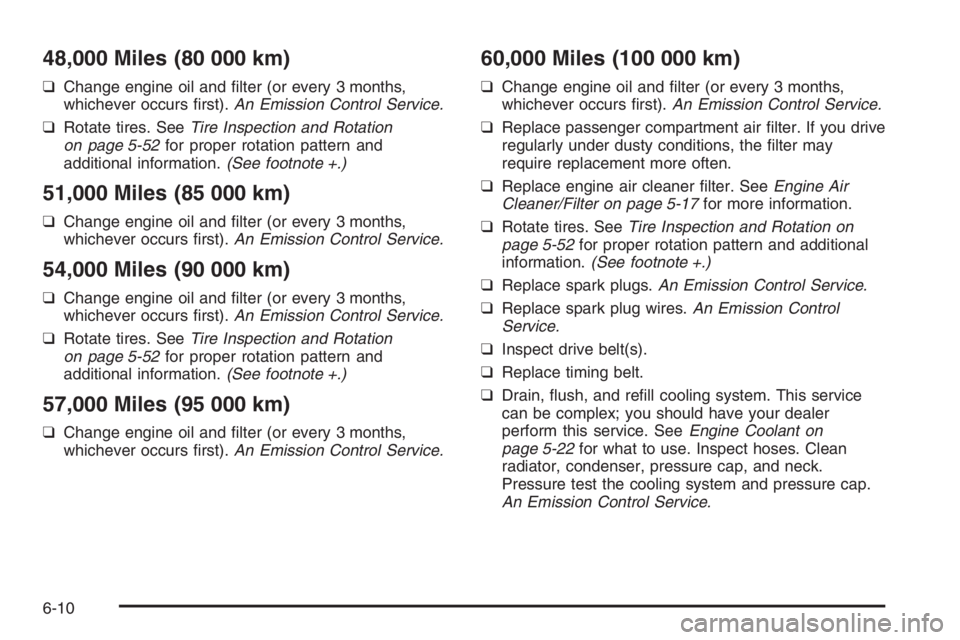
48,000 Miles (80 000 km)
❑ Change engine oil and filter (or every 3 months,
whichever occurs first). An Emission Control Service.
❑ Rotate tires. See Tire Inspection and Rotation
on page 5-52 for proper rotation pattern and
additional information. (See footnote +.)
51,000 Miles (85 000 km)
❑Change engine oil and filter (or every 3 months,
whichever occurs first). An Emission Control Service.
54,000 Miles (90 000 km)
❑Change engine oil and filter (or every 3 months,
whichever occurs first). An Emission Control Service.
❑ Rotate tires. See Tire Inspection and Rotation
on page 5-52 for proper rotation pattern and
additional information. (See footnote +.)
57,000 Miles (95 000 km)
❑Change engine oil and filter (or every 3 months,
whichever occurs first). An Emission Control Service.
60,000 Miles (100 000 km)
❑Change engine oil and filter (or every 3 months,
whichever occurs first). An Emission Control Service.
❑ Replace passenger compartment air filter. If you drive
regularly under dusty conditions, the filter may
require replacement more often.
❑ Replace engine air cleaner filter. See Engine Air
Cleaner/Filter on page 5-17 for more information.
❑ Rotate tires. See Tire Inspection and Rotation on
page 5-52 for proper rotation pattern and additional
information. (See footnote +.)
❑ Replace spark plugs. An Emission Control Service.
❑ Replace spark plug wires. An Emission Control
Service.
❑ Inspect drive belt(s).
❑ Replace timing belt.
❑ Drain, flush, and refill cooling system. This service
can be complex; you should have your dealer
perform this service. See Engine Coolant on
page 5-22 for what to use. Inspect hoses. Clean
radiator, condenser, pressure cap, and neck.
Pressure test the cooling system and pressure cap.
An Emission Control Service.
6-10